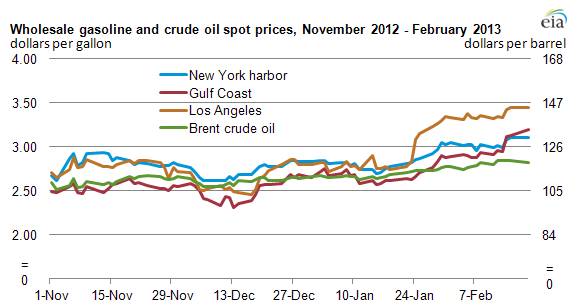The major factors behind the increase in gasoline crack spreads are: planned and unplanned refinery maintenance; the low starting level for gasoline crack spreads going into 2013; preparation for seasonal fuel specification changes; and developments in global product demand that have affected domestic refinery utilization rates, maintenance needs, and product balances.

Throughout much of November and December 2012, gasoline crack spreads were very low, and in some cases negative (a barrel of gasoline worth LESS than a barrel of Brent crude). As a result, retail gasoline prices were lower than one would typically expect given prevailing crude oil prices, with the lowest price of 2012 reached in EIA's weekly survey on December 17. Since the beginning of 2013, reformulated gasoline blendstock for oxygenate blending (RBOB) crack spreads versus Brent have increased 12, 34, and 46 cents per gallon, respectively, in New York Harbor, the Gulf Coast, and Los Angeles.
Both planned and unplanned maintenance at several refineries have supported higher crack spreads. Many refineries schedule maintenance early in the year when gasoline demand is seasonally low.

The U.S. average retail price of regular gasoline increased 14 cents to $3.75 per gallon, up 16 cents from last year at this time. The national average price has seen double digit increases two out of the last three weeks and is up 45 cents since the beginning of the year. The largest increase came in the Midwest, where the price increased 18 cents to $3.76 per gallon. The Gulf Coast price is $3.53 per gallon, an increase of 15 cents from last week. The Rocky Mountain price is up 14 cents to $3.41 per gallon. On the West Coast, the price increased 11 cents, but remains just shy of the $4 per gallon mark at $3.97 per gallon. Rounding out the regions, the East Coast price saw the smallest increase, 10 cents, rising to $3.75 per gallon.

(DOE-EIA, Petroleum & Other Liquids, DOE-EIA)
No comments:
Post a Comment